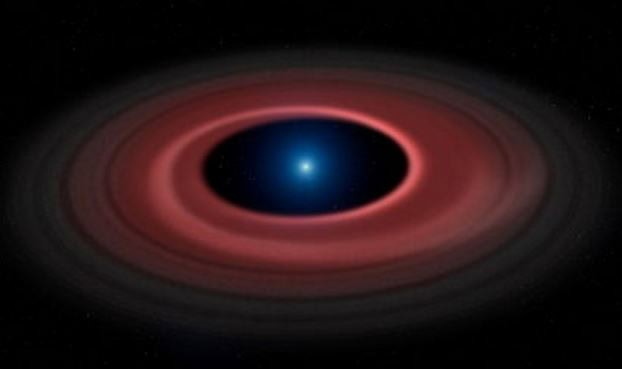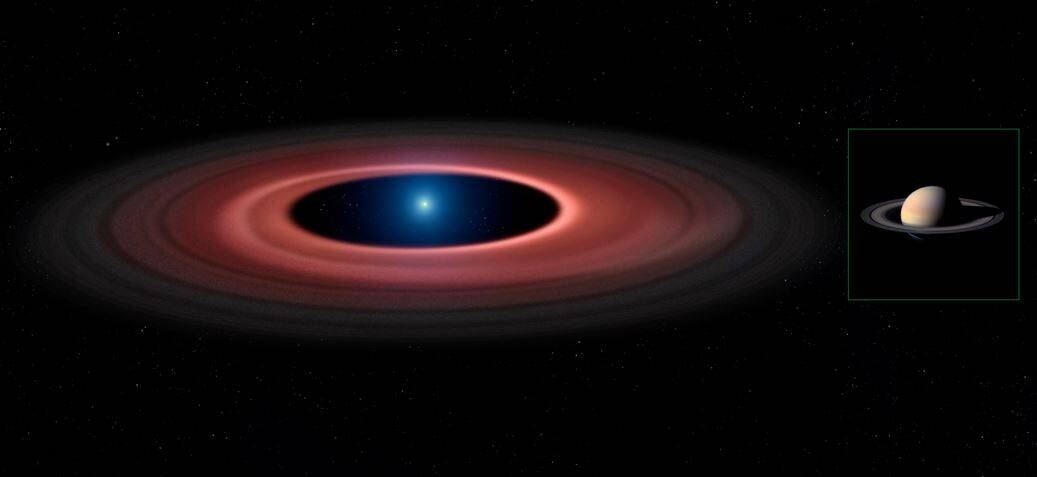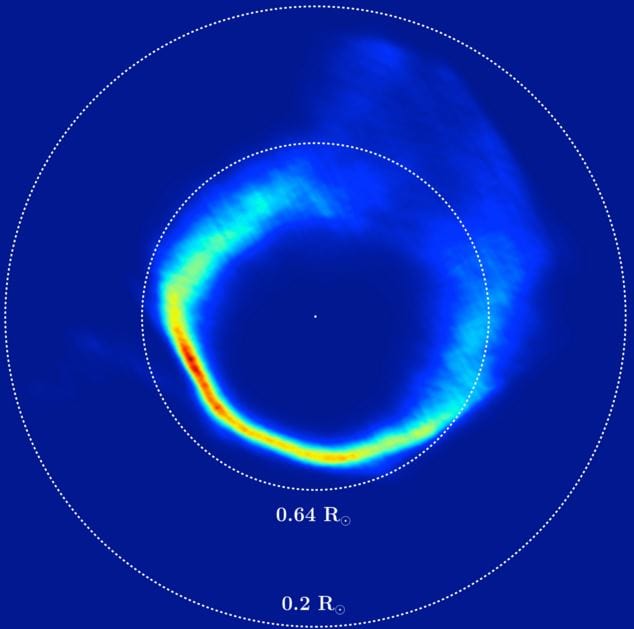An asteroid being ripped apart by a dead star, and forming a ring of glowing debris has been captured in an image by scientists from the University of Warwick’s Astrophysics Group in England. This is the first time such an image has been captured.
Consisting of dust particles and debris, the rings were formed by the gravitational pull of the star sucking in the asteroids that came too near.
When the pieces of debris collided within the ring, gas was produced, which was illuminated by ultraviolet rays from the star, causing it to emit a dark, red glow which the scientists were able to observe and turned into the image of the ring.
 A dead star (white dwarf), surrounded by a ring made of dust particles and debris from an asteroid torn apart by its strong gravity. (Image: warwick.ac.uk. Credit: Mark Garlick/University of Warwick)
A dead star (white dwarf), surrounded by a ring made of dust particles and debris from an asteroid torn apart by its strong gravity. (Image: warwick.ac.uk. Credit: Mark Garlick/University of Warwick)
Study leader, PhD student Christopher Manser, and colleagues studied the remnants of the planetary system around the white dwarf star, called SDSS1228+1040.
Like Saturn’s rings, but much bigger
The rings are similar to the ones around Saturn, but on a much larger scale.
Mr. Manser explained:
“The diameter of the gap inside of the debris ring is 700,000 kilometres, approximately half the size of the Sun and the same space could fit both Saturn and its rings, which are only around 270,000 km across. At the same time, the white dwarf is seven times smaller than Saturn but weighs 2500 times more.”
Debris rings have been found around other stars, However, the imaging of SDSS1228+1040 is unique – it gives us an unprecedented insight into these systems’ structure.
Mr. Manser said:
“We knew about these debris disks around white dwarfs for over twenty years, but have only now been able to obtain the first image of one of these disks.”
 The debris disc around SDSS1228+1040 (left) in scale to Saturn and its rings (right). While the dead star is seven times smaller than Saturn, it weighs over 2,500 more. (Image: warwick.ac.uk. Credit: Mark Garlick/University of Warwick)
The debris disc around SDSS1228+1040 (left) in scale to Saturn and its rings (right). While the dead star is seven times smaller than Saturn, it weighs over 2,500 more. (Image: warwick.ac.uk. Credit: Mark Garlick/University of Warwick)
Image created using Doppler tomography
The research team used Doppler Tomography, which is similar to the technology used in hospitals called CT (Computed Tomography). Scans are taken from several different angles which are then all put together in a computer into an image.
With a CT scan, the device moves around the target area (the patient). In the case of the disk the researchers were observing, it was rotating very slowly, so they had to take data over a twelve-year period.
Mr. Manser said, regarding what he and his colleagues saw in the image:
“The image we get from the processed data shows us that these systems are truly disc-like, and reveal many structures that we cannot detect in a single snapshot. The image shows a spiral-like structure which we think is related to collisions between dust grains in the debris disc.”
 An image of the debris disk around SDSS1228+1040 made from observations spanning over twelve years. Using Doppler Tomography results in an image of the velocities within the disk, which has an ‘inside-out’ structure – gas nearer the white dwarf appears further away. The two dashed circles illustrate 0.2 and 0.64 times the Sun’s radius. (Image: University of Warwick)
An image of the debris disk around SDSS1228+1040 made from observations spanning over twelve years. Using Doppler Tomography results in an image of the velocities within the disk, which has an ‘inside-out’ structure – gas nearer the white dwarf appears further away. The two dashed circles illustrate 0.2 and 0.64 times the Sun’s radius. (Image: University of Warwick)
What will happen when our Sun dies?
The scientists argue that systems such as SDSS1228+1040 are a glimpse at our own solar system’s future once our Sun starts to die.
By observing and studying these systems, we will be able to answer many questions, such as whether there are other planetary systems like ours, or what might eventually happen to our own solar system.
Professor Boris Gänsicke, of the University of Warwick’s Astrophysics Group said:
“When we discovered this debris disk orbiting the white dwarf SDSS1228+1040 back in 2006, we thought we saw some signs of an asymmetric shape. However, we could not have imagined the exquisite details that are now visible in this image constructed from twelve years of data – it was definitely worth the wait.”
“Over the past decade, we have learned that remnants of planetary systems around white dwarfs are ubiquitous, and over thirty debris disks have been found by now. While most of them are in a stable state, just like Saturn’s rings, a handful are seen to change, and it is those systems that can tell us something about how these rings are formed.”

